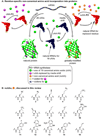Residue-specific incorporation of non-canonical amino acids into proteins: recent developments and applications
- PMID: 21071259
- PMCID: PMC3008400
- DOI: 10.1016/j.cbpa.2010.09.013
Residue-specific incorporation of non-canonical amino acids into proteins: recent developments and applications
Abstract
Residue-specific incorporation of non-canonical amino acids into proteins allows facile alteration and enhancement of protein properties. In this review, we describe recent technical developments and applications of residue-specific incorporation to problems ranging from elucidation of biochemical mechanisms to engineering of protein-based biomaterials. We hope to inform the reader of the ease and broad utility of residue-specific non-canonical amino acid incorporation with the goal of inspiring investigators outside the field to consider applying this tool to their own research.
Copyright © 2010 Elsevier Ltd. All rights reserved.
Figures


Similar articles
-
Molecular Evolution Directs Protein Translation Using Unnatural Amino Acids.Curr Protoc Chem Biol. 2015 Dec 2;7(4):223-228. doi: 10.1002/9780470559277.ch150115. Curr Protoc Chem Biol. 2015. PMID: 26629613 Review.
-
Residue-Specific Incorporation of Noncanonical Amino Acids for Protein Engineering.Methods Mol Biol. 2018;1728:137-145. doi: 10.1007/978-1-4939-7574-7_8. Methods Mol Biol. 2018. PMID: 29404995
-
Incorporation of non-canonical amino acids into proteins in yeast.Fungal Genet Biol. 2016 Apr;89:137-156. doi: 10.1016/j.fgb.2016.02.002. Epub 2016 Feb 8. Fungal Genet Biol. 2016. PMID: 26868890 Review.
-
Ribosomal incorporation of backbone modified amino acids via an editing-deficient aminoacyl-tRNA synthetase.Org Biomol Chem. 2018 Feb 14;16(7):1073-1078. doi: 10.1039/c7ob02931d. Org Biomol Chem. 2018. PMID: 29367962 Free PMC article.
-
Residue-specific Incorporation of Noncanonical Amino Acids into Model Proteins Using an Escherichia coli Cell-free Transcription-translation System.J Vis Exp. 2016 Aug 1;(114):54273. doi: 10.3791/54273. J Vis Exp. 2016. PMID: 27500416 Free PMC article.
Cited by
-
A Modular Method for the High-Yield Synthesis of Site-Specific Protein-Polymer Therapeutics.Angew Chem Int Ed Engl. 2016 Aug 22;55(35):10296-300. doi: 10.1002/anie.201604661. Epub 2016 Jul 21. Angew Chem Int Ed Engl. 2016. PMID: 27439953 Free PMC article.
-
Protein Synthesis with Ribosomes Selected for the Incorporation of β-Amino Acids.Biochemistry. 2015 Jun 16;54(23):3694-706. doi: 10.1021/acs.biochem.5b00389. Epub 2015 Jun 2. Biochemistry. 2015. PMID: 25982410 Free PMC article.
-
Cellular Site-Specific Incorporation of Noncanonical Amino Acids in Synthetic Biology.Chem Rev. 2024 Sep 25;124(18):10577-10617. doi: 10.1021/acs.chemrev.3c00938. Epub 2024 Aug 29. Chem Rev. 2024. PMID: 39207844 Review.
-
Artificial Small Molecules as Cofactors and Biomacromolecular Building Blocks in Synthetic Biology: Design, Synthesis, Applications, and Challenges.Molecules. 2023 Aug 3;28(15):5850. doi: 10.3390/molecules28155850. Molecules. 2023. PMID: 37570818 Free PMC article. Review.
-
A Diene-Containing Noncanonical Amino Acid Enables Dual Functionality in Proteins: Rapid Diels-Alder Reaction with Maleimide or Proximity-Based Dimerization.Angew Chem Int Ed Engl. 2019 Jun 17;58(25):8489-8493. doi: 10.1002/anie.201903494. Epub 2019 May 14. Angew Chem Int Ed Engl. 2019. PMID: 31018033 Free PMC article.
References
-
- Munier R, Cohen GN. Incorporation of structural analogs of amino acids in bacterial proteins. Biochim. Biophys. Acta. 1956;21:592–593. - PubMed
-
- Yuksel D, Pamuk D, Ivanova Y, Kumar K. Protein engineering using noncanonical amino acids. Protein Eng. Des. 2010;205:221.
-
- Voloshchuk N, Montclare JK. Incorporation of unnatural amino acids for synthetic biology. Mol. BioSyst. 2010;6:65–80. - PubMed
Publication types
MeSH terms
Substances
Grants and funding
LinkOut - more resources
Full Text Sources
Other Literature Sources

